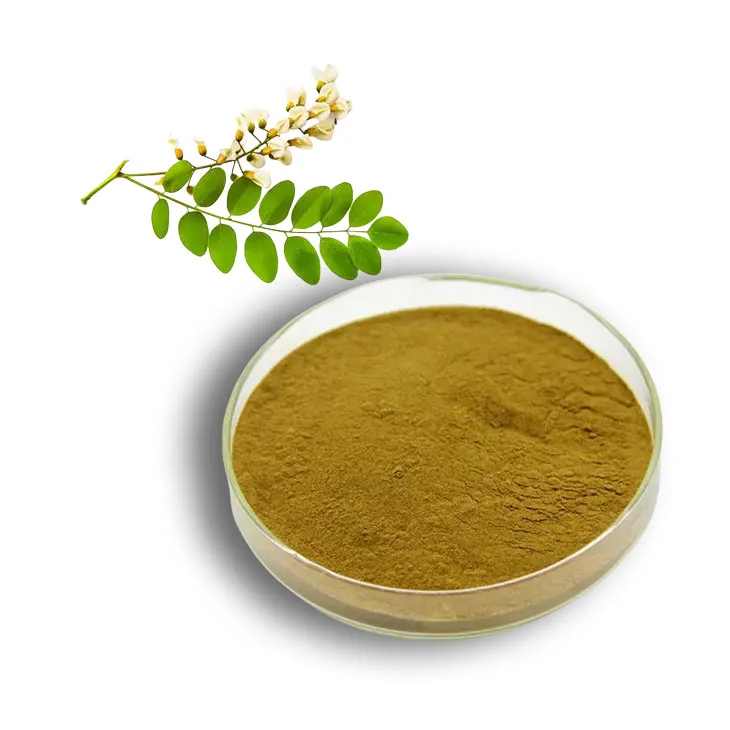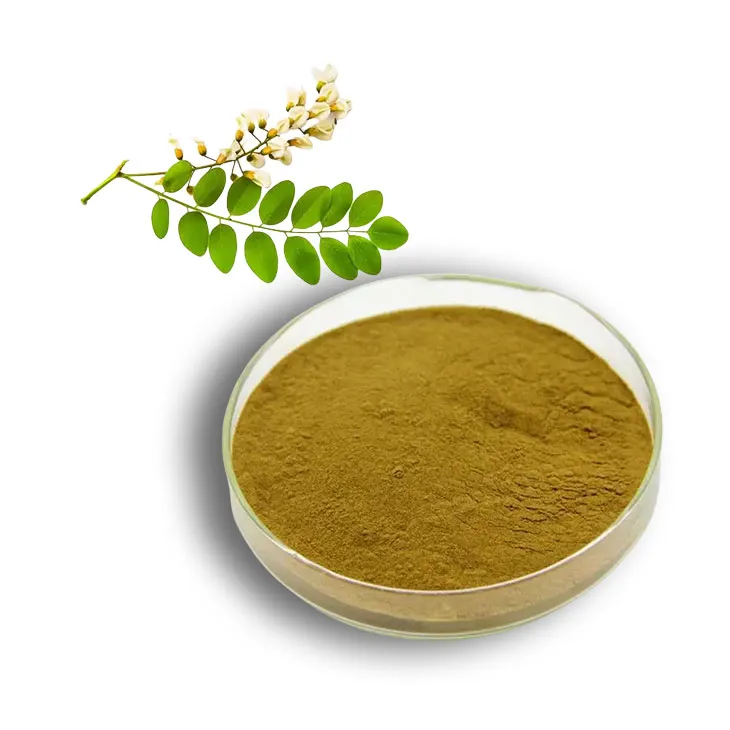- 0086-571-85302990
- sales@greenskybio.com
Sophora japonica Flower Extract: Uses, Advantages and Manufacturing Processes
2024-11-12

1. Introduction
The Sophora japonica flower has been a subject of interest for a long time due to its potential benefits. Sophora Japonica Flower Extract is obtained from this flower and has emerged as a valuable substance in various industries. This extract is rich in bioactive compounds that contribute to its diverse applications and advantages.

2. Uses in Medicine
2.1 Anti - inflammation
One of the significant pharmacological effects of Sophora Japonica Flower Extract in medicine is its anti - inflammatory property. Inflammatory responses in the body can lead to various diseases and discomfort. The extract contains certain compounds that can interfere with the inflammatory pathways.
- It can modulate the production of cytokines, which are key mediators in the inflammatory process. For example, it may reduce the over - production of pro - inflammatory cytokines such as interleukin - 1β (IL - 1β) and tumor necrosis factor - α (TNF - α).
- Studies have shown that in animal models of inflammation - related diseases, the administration of Sophora Japonica Flower Extract can alleviate symptoms such as swelling and redness.
2.2 Antioxidation
Another important use in medicine is its antioxidant activity. Oxidative stress occurs when there is an imbalance between the production of reactive oxygen species (ROS) and the body's antioxidant defense mechanisms. Sophora japonica flower extract can help in this regard.
- The extract is rich in antioxidants such as flavonoids. These antioxidants can scavenge free radicals, which are highly reactive molecules that can damage cells and DNA. By neutralizing free radicals, the extract helps protect cells from oxidative damage.
- It has been associated with a reduced risk of certain chronic diseases that are related to oxidative stress, such as cardiovascular diseases and neurodegenerative disorders. In vitro studies have demonstrated the extract's ability to inhibit lipid peroxidation, which is a marker of oxidative damage.
2.3 Other Potential Medical Uses
There are also other potential medical uses of Sophora japonica flower extract that are being explored.
- It may have antimicrobial properties. Some preliminary studies have suggested that it can inhibit the growth of certain bacteria and fungi, which could be beneficial in the treatment of infectious diseases.
- There is also interest in its potential role in modulating the immune system. A well - regulated immune system is crucial for maintaining health, and the extract may have the ability to enhance or balance immune responses.

3. Uses in Cosmetics
3.1 Skin Conditioning
In the field of cosmetics, Sophora japonica flower extract is highly regarded for its ability to improve skin conditions. It can be incorporated into various cosmetic products such as creams, lotions, and serums.
- The extract has moisturizing properties. It can help to retain water in the skin, preventing dryness and maintaining skin hydration. This is especially important for people with dry or sensitive skin.
- It also has anti - aging effects. The antioxidants present in the extract can combat the signs of aging caused by free radicals. It can help reduce the appearance of wrinkles, fine lines, and improve skin elasticity.
3.2 Soothing and Calming
The extract can also have a soothing and calming effect on the skin.
- For people with irritated or inflamed skin, such as those with acne or eczema, the anti - inflammatory properties of the extract can help reduce redness, swelling, and itching.
- It can be used in products designed for post - treatment skin care, for example, after a chemical peel or laser treatment, to promote skin recovery.

4. Uses in Food
The use of Sophora japonica flower extract in the food industry is also emerging. It can be used as a natural additive in food products.
4.1 As a Natural Preservative
Due to its antimicrobial properties, it has the potential to be used as a natural preservative.
- It can inhibit the growth of spoilage - causing microorganisms in food, thus extending the shelf life of food products. This is an attractive option for consumers who prefer natural alternatives to synthetic preservatives.
- Studies are being conducted to determine the optimal concentration and application methods to ensure food safety while maintaining the quality and taste of the food.
4.2 Flavor and Nutritional Enhancement
In addition to its preservative properties, the extract can also enhance the flavor and nutritional value of food.
- It may contribute a unique flavor profile to food products, adding a subtle and pleasant taste. This can be used in the development of new food products or to enhance the flavor of existing ones.
- The bioactive compounds in the extract can also provide additional nutritional benefits. For example, the antioxidants present can contribute to the overall antioxidant capacity of the diet.
5. Advantages of Sophora japonica Flower Extract
5.1 Natural Origin
One of the major advantages of Sophora japonica flower extract is its natural origin. It is derived from a plant source, which makes it appealing to consumers who are increasingly interested in natural products.
- Compared to synthetic substances, natural extracts are often perceived as being safer and more in harmony with the body. They are less likely to cause adverse reactions such as allergic reactions or long - term toxicity.
- The natural origin also gives it a certain "green" appeal, as it is a renewable resource. This is in line with the growing trend towards sustainable and environmentally - friendly products.
5.2 Safety Profile
Overall, Sophora japonica flower extract has a relatively good safety profile.
- While more research is still needed to fully understand its safety in all applications, preliminary studies suggest that at appropriate dosages, it is well - tolerated. In traditional medicine, the Sophora japonica flower has been used for a long time without significant reports of serious adverse effects.
- However, as with any substance, it is important to ensure proper quality control during the extraction and manufacturing process to avoid potential contaminants and ensure consistent safety.
6. Manufacturing Processes
6.1 Collection
The first step in the manufacturing process of Sophora japonica flower extract is the collection of the flowers. This step requires careful consideration.
- The flowers should be harvested at the appropriate time. Generally, they are collected when they are in full bloom. This is when the flowers contain the highest levels of bioactive compounds.
- The collection should be done in a sustainable manner to ensure the long - term availability of the plant. Only a certain percentage of the flowers should be harvested from each plant, leaving enough for the plant to reproduce and maintain its population.
6.2 Drying
After collection, the flowers need to be dried. Drying is an important step as it helps to preserve the bioactive compounds and prevent spoilage.
- There are different drying methods that can be used, such as air drying, sun drying, or using drying equipment. Air drying and sun drying are more traditional methods, but they may be affected by environmental factors such as humidity and temperature.
- Drying equipment, such as dehydrators, can provide more controlled drying conditions. The temperature and humidity can be adjusted to ensure optimal drying without causing damage to the bioactive compounds. The drying time also needs to be carefully monitored to ensure that the flowers are dried thoroughly but not over - dried.
6.3 Extraction
The final step in the manufacturing process is the extraction of the bioactive compounds from the dried flowers.
- There are several extraction methods available, including solvent extraction, supercritical fluid extraction, and ultrasonic - assisted extraction.
- Solvent extraction is a commonly used method. Different solvents such as ethanol, methanol, or water can be used. Ethanol is often preferred as it can effectively extract a wide range of bioactive compounds while being relatively safe and easy to handle. However, the choice of solvent depends on the specific compounds to be extracted and the intended application of the extract.
- Supercritical fluid extraction uses supercritical fluids, such as supercritical carbon dioxide. This method has the advantage of being more environmentally friendly as carbon dioxide is a non - toxic and easily removable gas. It can also provide a more selective extraction of bioactive compounds.
- Ultrasonic - assisted extraction uses ultrasonic waves to enhance the extraction efficiency. The ultrasonic waves can break the cell walls of the plant material more easily, allowing the bioactive compounds to be released more effectively.
7. Conclusion
In conclusion, Sophora japonica flower extract has a wide range of uses in medicine, cosmetics, and food. Its advantages, such as being natural and having a relatively good safety profile, make it an attractive option in various industries. The manufacturing process, although complex, can be optimized to produce high - quality extracts. With further research, it is expected that the potential of Sophora japonica flower extract will be fully explored and utilized, meeting the increasing demand for natural products in different sectors.
FAQ:
What are the main uses of Sophora japonica flower extract in medicine?
As mentioned, in medicine, Sophora japonica flower extract may have certain pharmacological effects such as anti - inflammation and antioxidation. Anti - inflammation can help in reducing inflammation in the body, which may be beneficial for conditions related to excessive inflammation. The antioxidation property can combat free radicals, which are associated with various diseases and aging processes.
How does Sophora japonica flower extract improve skin conditions in cosmetics?
In cosmetics, Sophora japonica flower extract can improve skin conditions in several ways. It may have antioxidant properties that protect the skin from free - radical damage, which can cause premature aging of the skin. It might also have anti - inflammatory effects on the skin, reducing redness and irritation. Additionally, it could potentially help in moisturizing the skin, making it look healthier and more radiant.
What are the steps in the manufacturing process of Sophora japonica flower extract?
The manufacturing process typically involves steps like collection, drying, and extraction. First, the Sophora japonica flowers are carefully collected. Then, they are dried to reduce moisture content. After that, extraction methods are used to obtain the extract. The extraction can be done using solvents such as ethanol or water, depending on the desired components and their solubility.
Why is Sophora japonica flower extract considered relatively safe?
Sophora japonica flower extract is considered relatively safe because it is a natural product. Natural products generally have a lower risk of causing severe adverse effects compared to synthetic chemicals. However, it should be noted that even natural products can cause allergic reactions in some individuals, but overall, when used properly, it has a good safety profile.
How does Sophora japonica flower extract meet the demand for natural products in various industries?
With the increasing consumer preference for natural products in industries like medicine, cosmetics, and food, Sophora japonica flower extract offers a natural alternative. It can provide the desired pharmacological, cosmetic, or flavor - enhancing effects without the use of synthetic substances. Its natural origin makes it appealing to consumers who are more conscious about the ingredients in the products they use.
Related literature
- The Pharmacological Properties of Sophora japonica Flower Extract"
- "Sophora japonica Flower Extract in Cosmetics: A Review"
- "Manufacturing Processes of Botanical Extracts: Focus on Sophora japonica"
- ▶ Hesperidin
- ▶ Citrus Bioflavonoids
- ▶ Plant Extract
- ▶ lycopene
- ▶ Diosmin
- ▶ Grape seed extract
- ▶ Sea buckthorn Juice Powder
- ▶ Fruit Juice Powder
- ▶ Hops Extract
- ▶ Artichoke Extract
- ▶ Mushroom extract
- ▶ Astaxanthin
- ▶ Green Tea Extract
- ▶ Curcumin
- ▶ Horse Chestnut Extract
- ▶ Other Product
- ▶ Boswellia Serrata Extract
- ▶ Resveratrol
- ▶ Marigold Extract
- ▶ Grape Leaf Extract
- ▶ New Product
- ▶ Aminolevulinic acid
- ▶ Cranberry Extract
- ▶ Red Yeast Rice
- ▶ Red Wine Extract
-
Green Tea Extract
2024-11-12
-
Yohimbine Bark Extract
2024-11-12
-
Almond Extract Powder
2024-11-12
-
Green coffee bean Extract
2024-11-12
-
Cactus Extract
2024-11-12
-
Moringa powder
2024-11-12
-
Eucommia Ulmoides Extract
2024-11-12
-
Lotus leaf extract
2024-11-12
-
White mustard seed extract
2024-11-12
-
Resveratrol extract
2024-11-12





















